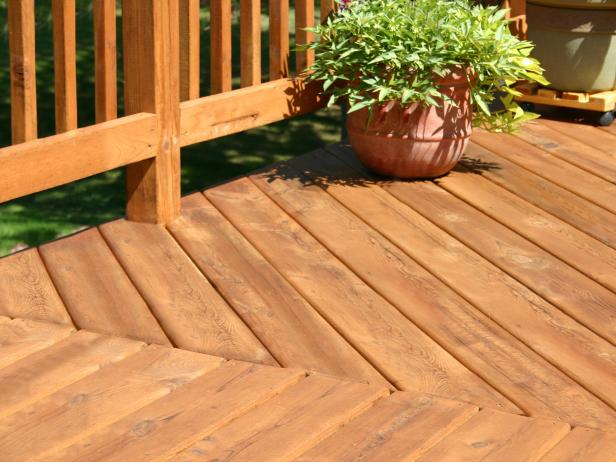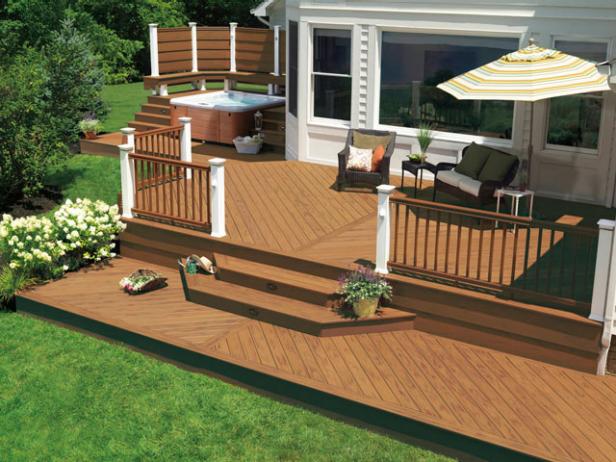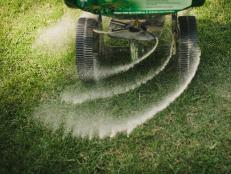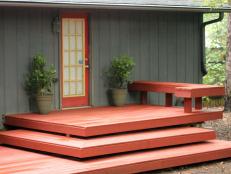How to Seal a Deck
Keep your wood deck looking beautiful by applying a fresh coat of deck sealer every year or two.

Beth Van trees
If you’ve opted for a clear or lightly tinted deck sealer to keep the grain of your wood deck showing through, good for you. Few surfaces can compete with the natural beauty of wood.
But your good intentions come with a DIY challenge: wood decks require vigilant maintenance to maintain their natural good looks, and you’ll have to refinish and seal your deck on a regular basis to keep it beautiful and splinter-free.
The job has two parts: cleaning the deck and applying a deck sealer.
Cleaning Your Deck
Start by removing any gunk and debris from between boards — screwdrivers and putty knives are good tools for this chore. Then give your deck a good sweeping.
To prep your deck for sealer, first give it a cleaning using a deck cleaner available at any hardware store or big box outlet. If you have a cedar or redwood deck that’s stained with mold or mildew, use a deck brightener to help remove stains.
Coastal-Style Decks, Patios and Porches 27 Photos
Breezy, beachy-good looks turn these outdoor spaces into relaxing, inviting gathering spots.
You’ll want to protect nearby shrubs and plants with plastic sheets before you start, and choose a cloudy — but not rainy — day for applying the deck cleaner. That way, the sun won’t dry out the cleaner too fast. Apply the cleaner with a paint roller, a garden sprayer, or a bristle brush. To clean wood railings and posts, work from the bottom up. If you work from the top down, spills and splatters can get on dry wood, leaving spots that are difficult to remove.
Let the cleaner sit according the manufacturer’s directions, then rinse thoroughly. Let your deck dry completely — give it at least 48 hours before applying a deck sealer.
Applying a Deck Sealer
Sealers and stains are available at home improvement centers for about $30 per gallon — enough to cover 250 square feet of decking. Your finish options include:
When it comes to choosing the best deck sealer, you’ve got several choices. In general, the more opaque the sealer, the better its weather- and wear-fighting abilities. However, lighter finishes let more of the wood’s natural grain and beauty show through. The more clear the deck sealant, the more often you’ll have to clean and seal your deck.

©iStockphoto.com/NinaMalyna
• Clear and wood-toned sealers enhance wood’s natural grain and color.
• Semi-transparent deck sealer/stains are lightly pigmented and let grain show through but change the tone of your wood. They come in shades of blue, gray, brown, green and red.
Check the forecast for a clear, two-day period with moderate temps between 50 and 90 degrees. Sand the deck to remove any fuzzy grain raised by the washing. Use 80-grit sandpaper, and thoroughly sweep or vacuum the decking when you're done. This is a good time to countersink any raised nail heads or popped screws.
Apply painter’s tape to any nearby surfaces — such as siding — that you need to protect. Apply the deck sealer with a natural bristle brush. A roller is faster, but brushing helps force the sealer into open pores and grain. Make sure to get the sealer into joints where two boards butt together. Apply the deck sealer to three or four boards at once, working their entire length. You don’t want to spill or lap over onto adjacent boards or you’ll have splotches that are hard to conceal.

TimberTech














































